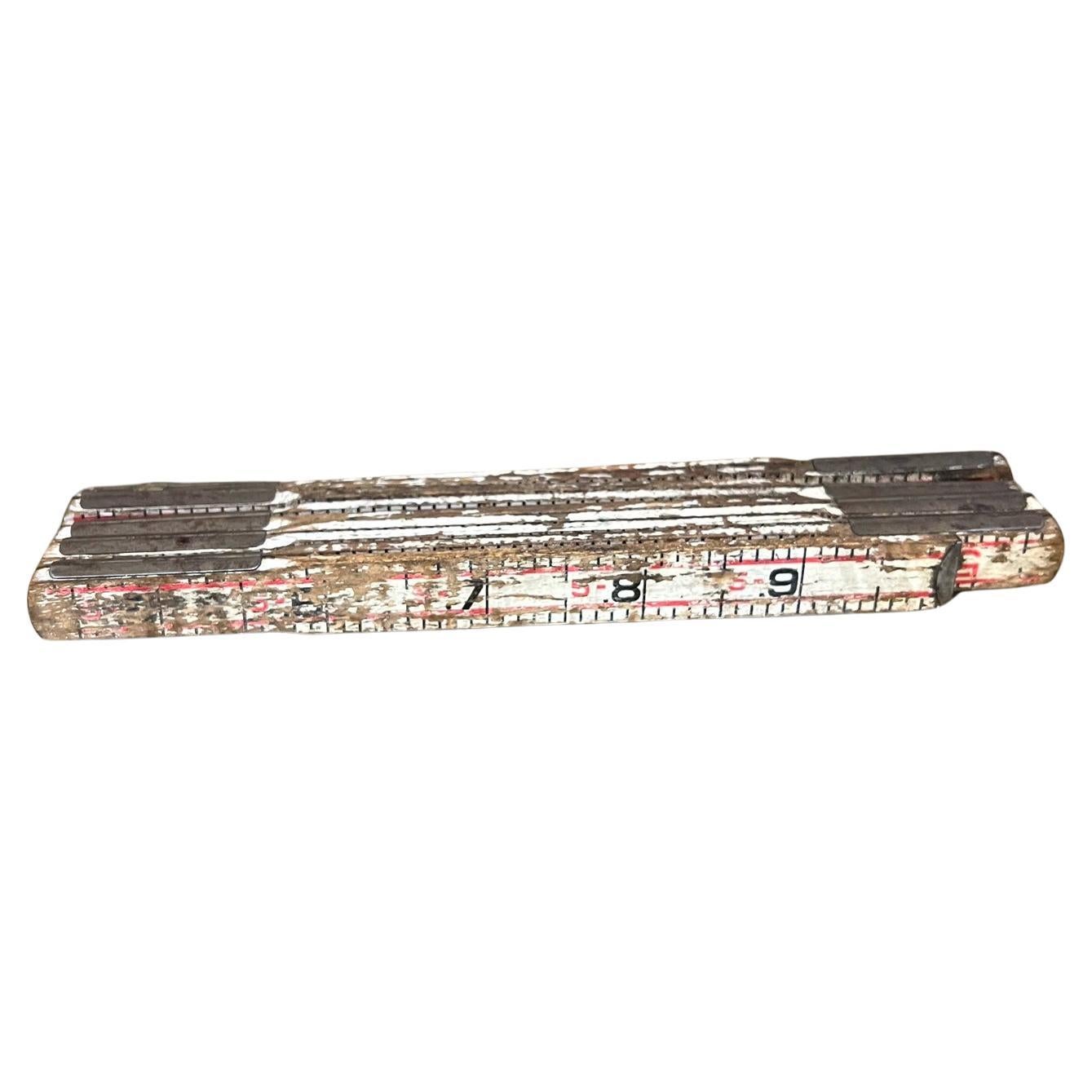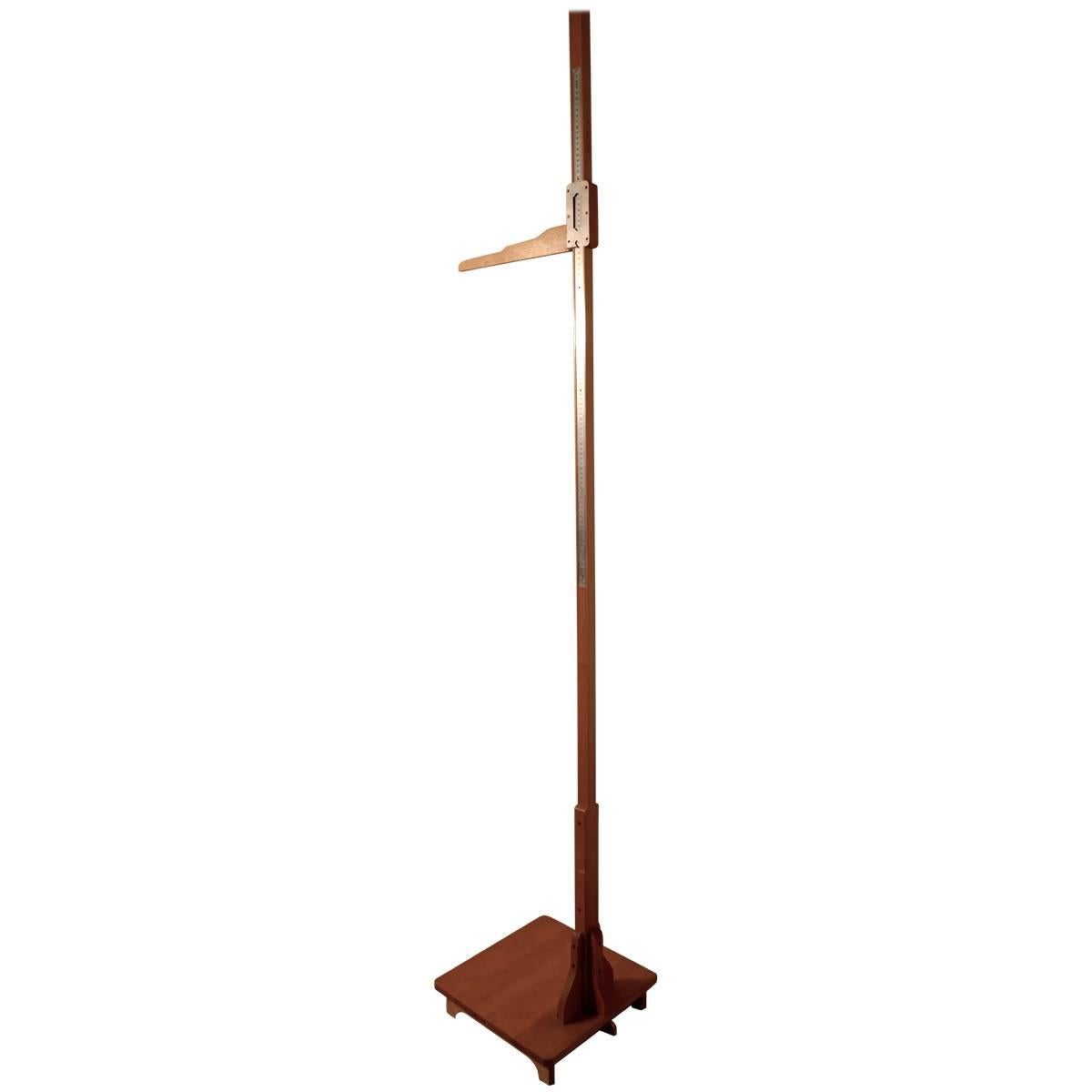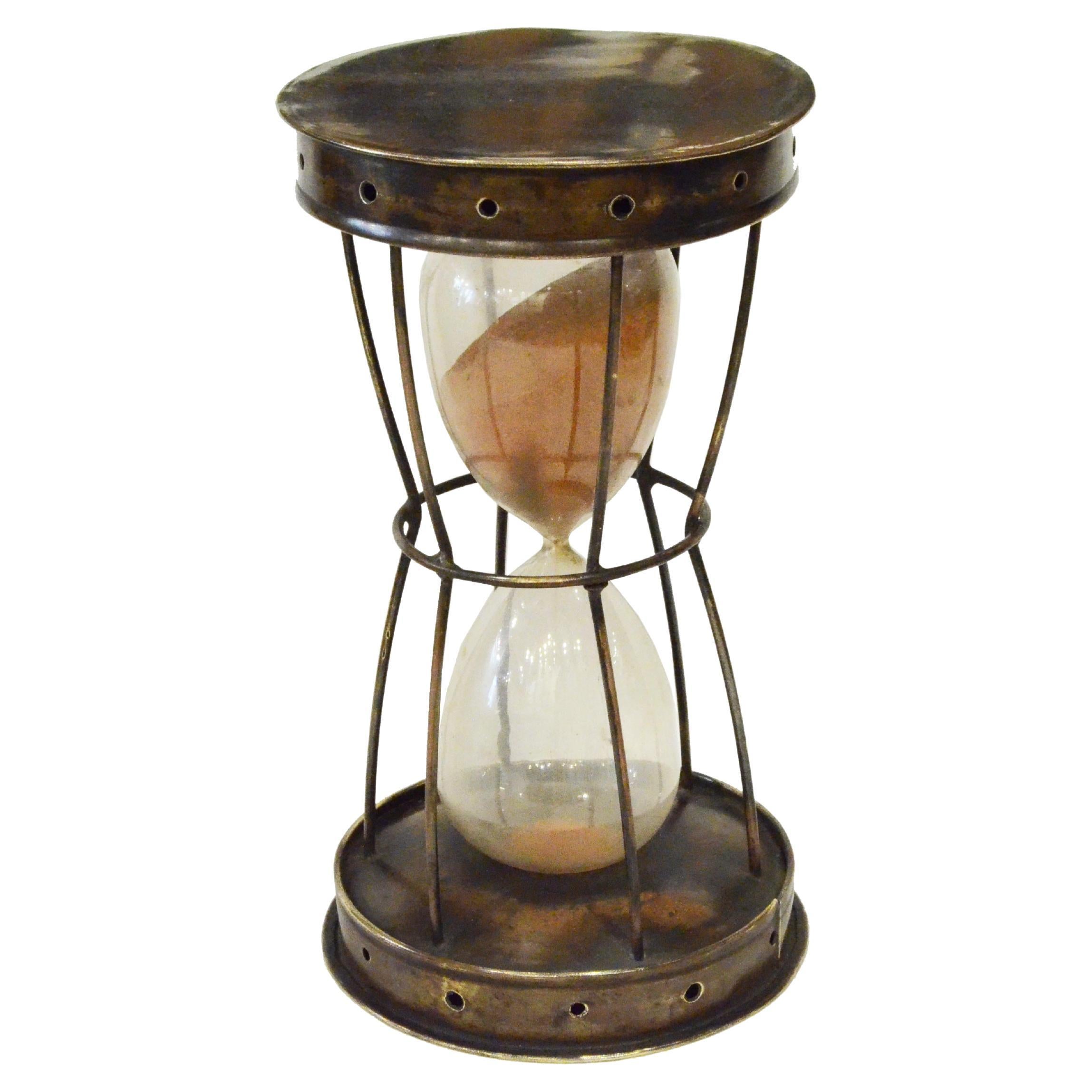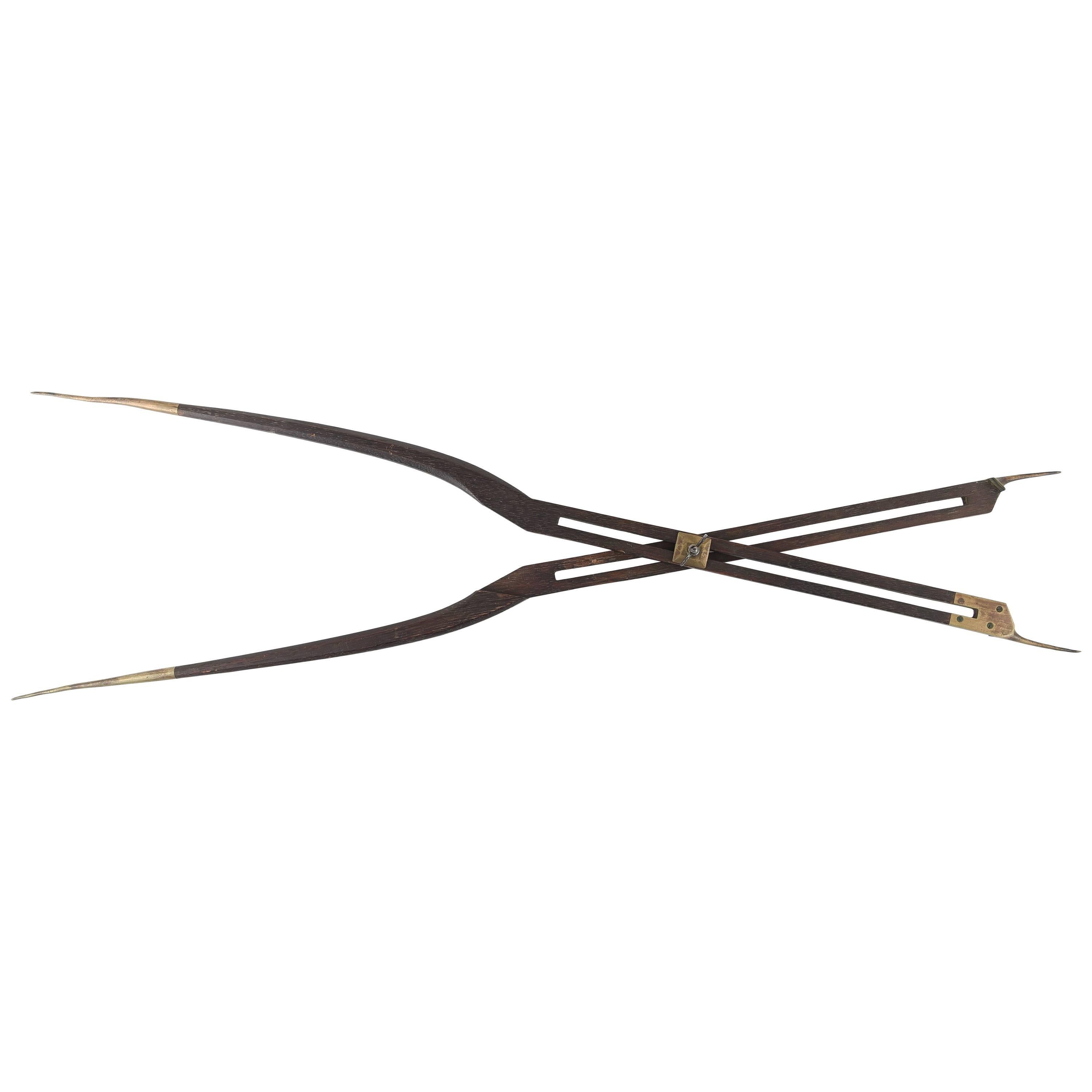Items Similar to Antique Brass and Wood Height Measure, Country House.
Want more images or videos?
Request additional images or videos from the seller
1 of 16
Antique Brass and Wood Height Measure, Country House.
About the Item
7ft Vintage Free-standing Height Measure.
An early 20th century Edwardian height measuring stand with adjustable cross bar, normally found in doctor's surgeries or chemist shops but this one came from a Grade II listed Georgian country house in Wootton, Oxfordshire, known as 'Woodleys'. It has a paper label 'Woodleys Upstairs' tied to it. Woodleys came on to the market last year, the first time since it was bought by the family in 1881, extending to over 12,800 sq ft, with 9 principal bedrooms. Set in its own parkland with an iconic view of Blenheim Palace. There are beautiful walled gardens, 3 cottages, stone barns, and a farmyard with an extensive footprint of buildings, all in about 230 acres.
The stand base is made of cast iron with a bronze hollow tube (92 cm long) fixed to it. A square wooden measuring stick is held in place in the tube by a large wing nut. The stick is made of mahogany with a boxwood face which has the measurements on, starting at 3 foot with increments of an inch (divided into eighths) all the way up to 7 foot. A sliding cross bar, measuring arm, is 49 cm long and has a brass sleeve with an internal spring inside to hold it in place when moved up the rule. The measure pole can be retracted inside the bronze stand for storage by releasing the wing nut.
A charming piece of piece of history in good condition, no breaks or other damage.
One of Oxfordshire's most impeccably situated, but least-known country houses has just been launched onto the market: the timeless, Grade II- listed Woodleys at Wootton, which sits at the heart of a historic, 230-acre, residential and farming estate on the edge of the Cotswold AONB, three miles from Woodstock, 10 miles from Chipping Norton and 12 miles from Oxford. for the imposing late-Georgian house, which stands in wooded gardens, grounds and parkland to the north of the Duke of Marlborough's Blenheim estate, looking south across the gardens to Blenheim Palace in the distance.
Taken from 'Country Life'.
Dimensions:
Height
230 cm / 90 "
Width
31 cm / 12 "
Depth
41 cm / 16 1⁄4"
Period
1900-1949
Year
Circa 1905
Medium
Cast iron, bronze & wood
Country
United Kingdom
Condition
Very good usable condition.
- Dimensions:Height: 90 in (228.6 cm)Width: 12 in (30.48 cm)Depth: 16.25 in (41.28 cm)
- Materials and Techniques:
- Place of Origin:
- Period:1900-1909
- Date of Manufacture:Circa 1905
- Condition:Wear consistent with age and use.
- Seller Location:Oxfordshire, GB
- Reference Number:
About the Seller
5.0
Platinum Seller
These expertly vetted sellers are 1stDibs' most experienced sellers and are rated highest by our customers.
Established in 1977
1stDibs seller since 2013
688 sales on 1stDibs
Typical response time: 1 hour
Associations
LAPADA - The Association of Arts & Antiques Dealers
- ShippingRetrieving quote...Ships From: Oxfordshire, United Kingdom
- Return PolicyA return for this item may be initiated within 3 days of delivery.
More From This SellerView All
- Antique Brass Club FenderLocated in Oxfordshire, GBVintage Brass Club Fender. A wonderful club fender with an open front, brass uprights and a shaped brass base. The upholstered seat is 20 cm wide with the measurements inside the sea...Category
Late 20th Century British Sports Equipment and Memorabilia
MaterialsBrass
- Antique Sporting Pen Knife, Shooting, Tennis 1930s Brass and SteelLocated in Oxfordshire, GBA folding sporting penknife with inoxydable bronze handle. A good traditional French manufactured knife by Coursolle, their trademark logo being 'adjustable wrenches'. The penknife c...Category
Vintage 1930s French Sports Equipment and Memorabilia
MaterialsBronze
- Antique Yew Wood Long Bow, ArcheryLocated in Oxfordshire, GBVintage Thomas Aldred Longbow in stock. It is a very good ladies archery yew wood long bow, produced by Thomas Aldred, London. The bow is fitted with two hor...Category
Antique Late 19th Century British Sporting Art Sports Equipment and Memo...
MaterialsYew
- Antique Brass Salmon Fishing ReelLocated in Oxfordshire, GBA beautiful salmon fishing reel by Cummings of Bishop Auckland. This brass or gun metal reel is a very nice original example with the original coating. ...Category
Antique Early 1900s British Edwardian Sports Equipment and Memorabilia
MaterialsBrass
- A Pair of Antique Transitional Long Nose Golf Clubs, Woods.Located in Oxfordshire, GBAntique Scared Head Charles Ramage Woods. An elegant pair of transitional scared head beech wood hickory golf clubs by Charles Ramage, Brighton & Hove Golf Club (1888 - 1902). This great looking pair of usable scared head clubs, driver and brassie, have polished golden club heads, lead weight to the rear, traditional insert along the leading edge of the sole, brassie with full brass sole plate, both heads stamped 'C Ramage'. The original hickory shafts fitted with good hide grips with thick underlisting. Approximate head size of Driver (front club) :- a = 9 cm b = 3.4 cm c = 5 cm Club is 110 cm in length and has an approximate 5° Loft. Swing weight D-9. Approximate head size of Brassie (rear club):- a = 7 cm b = 3.5 cm c = 4.9 cm Club is 109 cm length and has an approximate 8° Loft. Swing weight E-2. This is a great example of a pair of a scared head golf clubs from the 1890's in excellent usable condition. The early clubs are made with a hickory shaft glued to the head by means of a splice or scare joint. This joint is then further strengthened by whipping with a pitched thread. All beautifully hand made by craftsmen of the time. Charles Ramage born 2nd September 1856 in North Berwick, son of William Ramage, quarryman and his wife Ann Greig. Charles was a plasterer to trade and during the season he was a licensed caddie on the West Links. He resided with his mother, step-brother Andrew Denholm and Charles Gibson at 42 Westgate, (now No.47) North Berwick. Charles Gibson, a 22-year-old golf clubmaker from Musselburgh was employed by Tom Dunn in his workshop beside the first tee on the West Links, North Berwick. Charles Ramage's sister Helen born 5th June 1853 married Charles Gibson in the Abbey Church, North Berwick on 30th December 1881 and they set up home at 27 Westgate, North Berwick before moving to Devon in 1889. Charles 'Chas' Ramage's neighbour at 41 Westgate was Tom Arundel, a clubmaker who was the first player to enter the Open Championship from North Berwick in 1879. The adjacent property was occupied by Ben Sayers and his family for a short period. Charles Ramage married Bessie Scotland from Kinross in 1884 and they resided at 23 Quality Street, North Berwick. In 1886 Charles Ramage worked as a clubmaker with Tom Dunn and was a fine 'bulger' maker (a driving club with a convex face). In 1888 he was the first professional and clubmaker to be appointed to the newly opened nine-hole-course at Brighton & Hove Golf Club. In 1891 the members organised a professional tournament played for £10. The field included Charles Ramage, Douglas Rolland, Peter Paxton (winner), Tom Dunn, Charles Gibson, George Douglas, David Pinkerton, Alex. Alexander, Ramsay Hunter, Rowland Jones. During this period Charles and Bessie resided in Cowpie Road, before they moved to 49 Fonthill Road, Hove, Sussex. In 1891 Charles was joined at Brighton by his step-brother Andrew Denholm as his assistant. The course commanded stunning views over the Sussex Downs and was served by the Brighton & Dyke Railway. Andrew Denholm born 23 September 1861, in Edinburgh son of George Denholm, gardener and his wife Ann Ramage. Andrew Denholm was an original member of the PGA and played in the Open Championship in 1900 and 1904. Charles Ramage died suddenly in 1893 aged 36 years and Andrew Denholm took over as professional and clubmaker at Brighton & Hove. In 1908, Andrew Denholm played in an exhibition match with James Braid...Category
Antique Late 19th Century British Sports Equipment and Memorabilia
MaterialsWood, Beech, Hickory
- Leather and Brass Cartridge Magazine, Holland and Holland LabelLocated in Oxfordshire, GBVintage Holland & Holland Leather Cartridge Magazine Case. A fine leather shooting cartridge magazine case by the renowned British gunmaker, Holland & Holland, 98 New Bond Street, L...Category
20th Century British Sports Equipment and Memorabilia
MaterialsLeather
You May Also Like
- Pharmacy Height Measure Stand, Pitch Pine Measuring Stick or SomastometreLocated in Chillerton, Isle of WightPharmacy Height Measure Stand, Pitch Pine Measuring Stick or Somastometre Once these along with scales were common place in Doctors Surgeries, Chemist S...Category
Mid-20th Century French Mid-Century Modern Scientific Instruments
- 19th Century Italian Height Measuring ApparatusLocated in Atlanta, GAAn intriguing 19th century Italian apparatus for measuring one's height in centimeters. Soundly constructed from cast iron with a bronze measure to one side. A whimsical accent perfe...Category
Antique Late 19th Century Italian Scientific Instruments
MaterialsBronze, Iron
- Antique Extension Ruler Wood Folding Measuring TapeBy StanleyLocated in Chula Vista, CAAMBIANIC presents Extension Ruler Rustic Wood Folding Tape Decorative Item Attributed to Lufkin or Stanley Closed .75 h x 1.75 d x 8 w, fully extended 55 fully extended Antique vinta...Category
Early 20th Century Industrial Scientific Instruments
MaterialsWood
- Salmoiraghi Antique Brass Tacheometer, Surveying Measuring Instrument, 1860Located in Milan, ITLa Filotecnica Ing A. Salmoiraghi Milan Centesimal tacheometer 133 b normal N. 55858 Catasto Italiano model of the second half of the 19th century, of burnished brass, complete with ...Category
Antique 1860s Italian Scientific Instruments
MaterialsBrass
- End XIX Century Brass and Glass Hourglass Antique Time Measuring InstrumentLocated in Milan, ITSand hourglass, brass container with circular base and tapered columns in the center and blown glass cruet. Duration 45 minutes. English manufacture of the early 1900s. Measures height 20 cm, diameter 11.5 cm – 7.9x4.5 inches. Shipping is insured by Lloyd's London; our gift box is free (look at the last picture). In Greece, the use of hourglasses was introduced in 325 BC, in the form of stone containers with a truncated cone shape that let water flow out of a hole in the bottom at a constant rate. Other hourglasses were cylindrical or cup-shaped and were slowly filled by a constant flow of water. Some signs on the inner surface of the container indicated the passage of hours as the liquid level rose. Another version consisted of a metal container with a hole in the bottom which, placed to float in a larger container, sank in a given time. This system remained in use until the 20th century in North Africa. These clocks were typically used at night, but not during the day, when the more accurate sundials were available. In the first half of the III century BC. Ctesibius transformed the hourglass into the more complex water clock. Various mechanisms were introduced by him and others to increase the precision of the watch by regulating the pressure and keeping the flow of water constant, but also to offer a better display of the time. The most advanced specimens could ring bells or gongs, open windows to display images, or had movable indicators, dials or representations of celestial bodies. Among the designers of watches...Category
Antique 1890s Scientific Instruments
MaterialsGlass
- Antique Wood and Brass ProtractorLocated in Norwalk, CTA really nice example of a handmade tool, this protractor is carved wood and fitted with handmade brass fittings.Category
Antique Late 19th Century Scientific Instruments
MaterialsBrass
Recently Viewed
View AllMore Ways To Browse
Vintage Garcia Spurs
Win Lighter
Jfk Memorabilia
Record Jukebox
Vintage Mercury Glass Birds
Vintage Railway Memorabilia
Rolling Stones Autograph
Vintage Mercury Glass Bird Ornament
Vintage Peanuts Collectibles
Flow Blue With Gold Collectible Plates
Antique Colonel Sword
Charlie Farrar
Galen Anatomy
Rafa Nadal
Vintage Military Wood Ammo Box
John F Kennedy Campaign Poster
Victorian Kids
Vintage Mercury Glass Ornament





